Mobile health platforms enhance nutrition management and wellness monitoring by providing personalized dietary recommendations and real-time health data. They promote informed decision-making through integration with wearable devices and community support. Users can navigate challenges related to usability and data privacy while benefiting from emerging trends like artificial intelligence and telehealth services. By leveraging these platforms effectively, individuals can achieve better health outcomes and maintain healthier lifestyles.
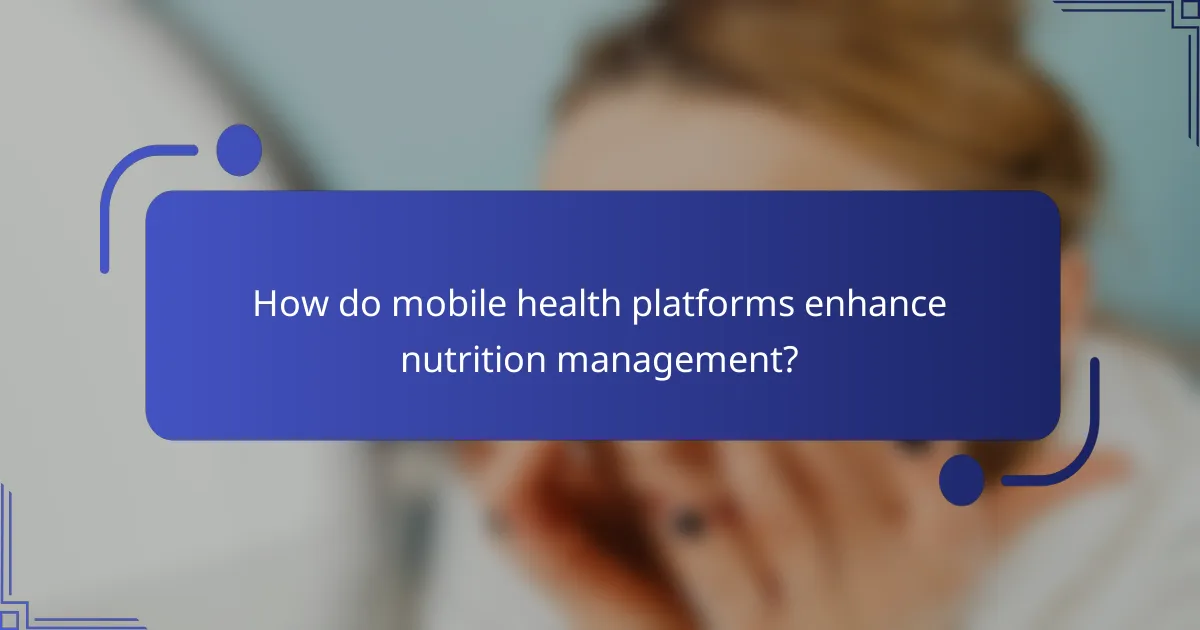
How do mobile health platforms enhance nutrition management?
Mobile health platforms significantly enhance nutrition management by offering personalized dietary recommendations, tracking nutrient intake, and promoting healthy habits. These platforms utilize data analytics to tailor nutrition plans based on individual health goals and preferences.
They provide real-time feedback, enabling users to make informed food choices. Integration with wearable devices allows for comprehensive tracking of physical activity and its impact on nutrition. As a result, users can achieve better health outcomes through informed decision-making.
Additionally, mobile health platforms often feature community support, fostering motivation and accountability among users. This social aspect can lead to improved adherence to nutrition plans and overall wellness.
What features facilitate personalized dietary planning?
Mobile health platforms facilitate personalized dietary planning through features like tailored meal recommendations, nutrient tracking, and user-specific goals. These platforms utilize data analytics to customize dietary advice based on individual health metrics and preferences. Features such as integration with wearable devices enhance real-time monitoring, allowing users to adjust their plans effectively. Additionally, community support and expert consultations provide motivation and accountability, enriching the overall user experience.
Which tools assist in tracking nutrient intake?
Mobile health platforms utilize various tools to effectively track nutrient intake. These tools include apps that allow users to log food consumption, scan barcodes for nutritional information, and access databases for meal planning. Popular platforms often feature personalized feedback, goal setting, and integration with wearable devices. This enhances user engagement and promotes better nutrition management.
How do integration capabilities with wearables improve user experience?
Integration capabilities with wearables significantly enhance user experience by providing real-time data and personalized insights. These platforms allow seamless tracking of health metrics, enabling users to make informed decisions about their nutrition and wellness. Enhanced connectivity fosters motivation through goal setting and progress monitoring. For instance, wearables can sync with mobile health applications to deliver tailored recommendations based on individual health data. This integration fosters a holistic approach to health management, improving user engagement and adherence to wellness plans.
What role do community features play in user engagement?
Community features significantly enhance user engagement on mobile health platforms by fostering interaction and support. These features, such as forums and group challenges, create a sense of belonging. Users are more likely to stay motivated and adhere to their wellness goals when they connect with others sharing similar journeys. Additionally, community-driven content, like user-generated tips and success stories, enriches the platform experience. This collaborative environment not only boosts user retention but also encourages active participation, leading to better health outcomes.
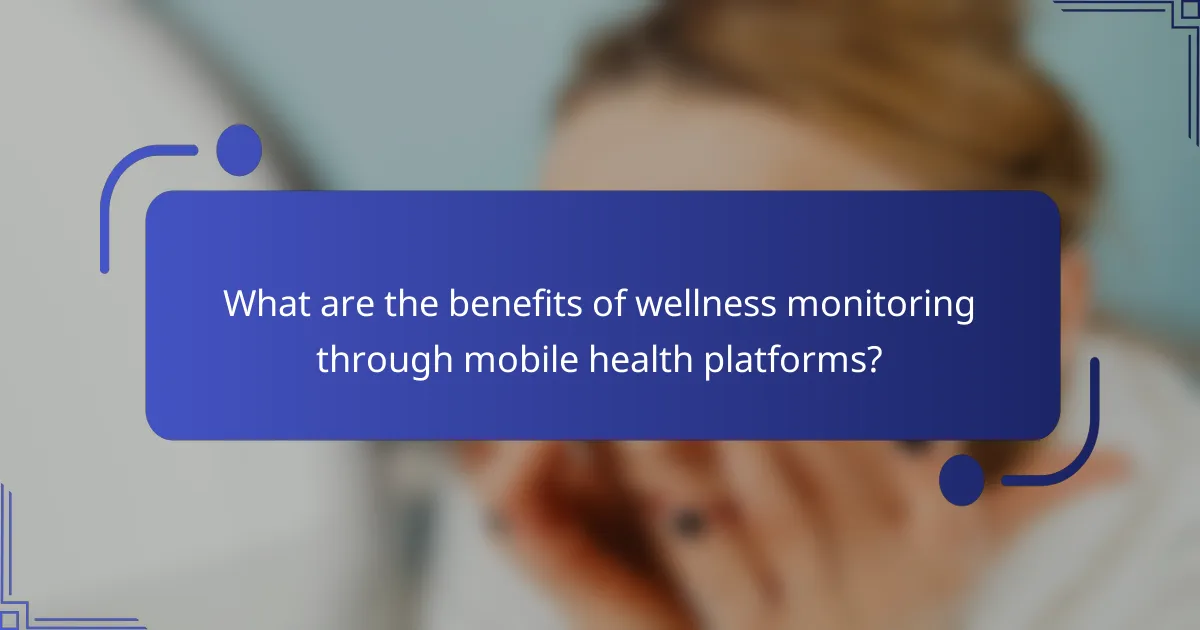
What are the benefits of wellness monitoring through mobile health platforms?
Mobile health platforms significantly enhance wellness monitoring by providing real-time data and personalized insights. These platforms facilitate tracking health metrics, improving user engagement in their wellness journey.
Key benefits include increased accessibility to health information, enabling users to monitor vital signs and lifestyle factors conveniently. This immediate feedback fosters better decision-making regarding nutrition and exercise.
Additionally, mobile health platforms often incorporate features like goal setting and reminders, which further motivate users to maintain healthy habits. The integration of community support can also enhance accountability and encourage sustained engagement.
As a result, these platforms not only improve individual health outcomes but also promote a proactive approach to wellness management.
How can real-time health data improve lifestyle choices?
Real-time health data enhances lifestyle choices by providing personalized insights into nutrition and wellness. Mobile health platforms collect data on dietary habits, physical activity, and health metrics, enabling users to make informed decisions.
These platforms often include features like meal tracking, nutrient analysis, and reminders for hydration or exercise. For example, users can receive alerts when they exceed calorie limits or fall short on essential nutrients.
Additionally, real-time feedback fosters accountability and motivation. Users can visualize their progress and adjust their habits accordingly. This immediate access to information empowers individuals to take control of their health and wellness journey.
Incorporating data analytics, these platforms can identify trends and suggest tailored lifestyle adjustments. As a result, users experience improved health outcomes and enhanced quality of life.
Which metrics are most commonly tracked for wellness monitoring?
Commonly tracked metrics for wellness monitoring include physical activity levels, heart rate, sleep quality, nutritional intake, stress levels, and weight management. These metrics provide a comprehensive view of an individual’s health status.
| Metric | Description | Purpose |
|———————-|———————————————|——————————————|
| Physical Activity | Steps taken, exercise duration | Assess fitness levels |
| Heart Rate | Beats per minute during activities | Monitor cardiovascular health |
| Sleep Quality | Duration and quality of sleep | Evaluate rest and recovery |
| Nutritional Intake | Daily calorie and nutrient consumption | Manage dietary habits |
| Stress Levels | Self-reported stress indicators | Identify mental health needs |
| Weight Management | Changes in body weight over time | Track overall health progress |
What impact does remote health monitoring have on chronic disease management?
Remote health monitoring significantly improves chronic disease management by providing real-time data and personalized insights. It enables timely interventions, enhances patient engagement, and facilitates better adherence to treatment plans.
Mobile health platforms allow continuous tracking of vital signs, medication adherence, and lifestyle factors. This data empowers healthcare providers to make informed decisions and adjust treatment strategies accordingly. For example, patients with diabetes can receive immediate feedback on their glucose levels, promoting proactive management.
Moreover, remote health monitoring reduces hospital visits and healthcare costs, making chronic disease management more efficient. Studies show that patients using these platforms experience improved health outcomes and greater satisfaction with their care.
In summary, remote health monitoring through mobile health platforms enhances chronic disease management by fostering timely interventions, improving patient engagement, and reducing overall healthcare costs.
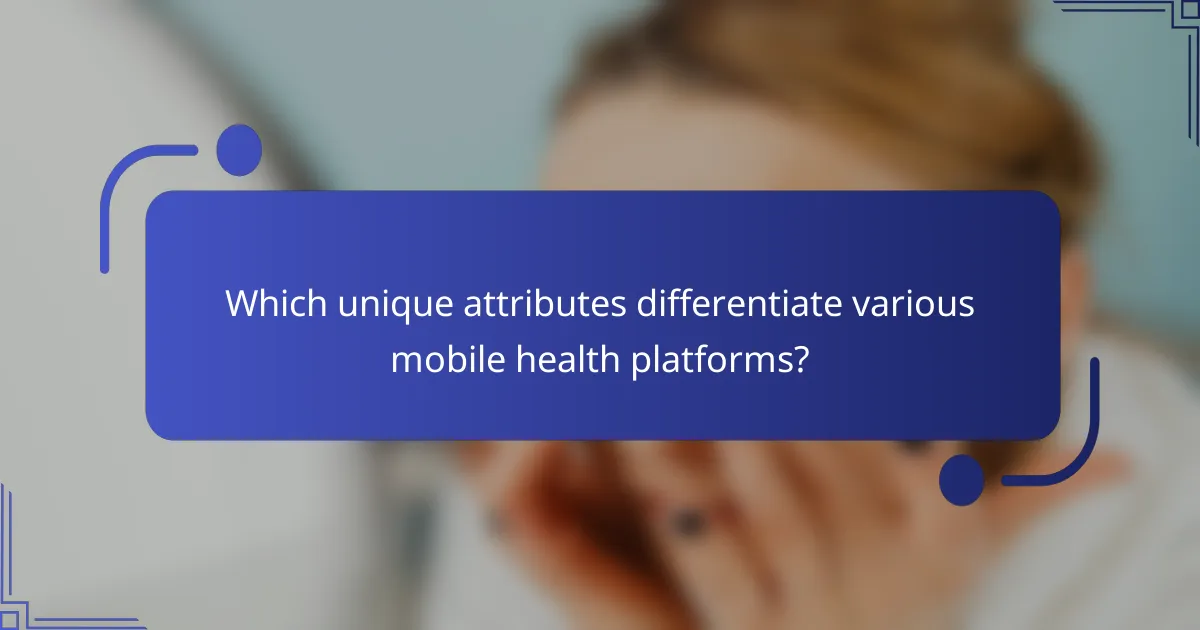
Which unique attributes differentiate various mobile health platforms?
Mobile health platforms differentiate through unique attributes like user interface design, integration capabilities, and data privacy features. These elements influence user engagement and overall effectiveness in nutrition management and wellness monitoring.
User interface design varies significantly, impacting ease of use and accessibility. Integration capabilities determine how well the platform connects with other health devices and applications. Data privacy features are crucial, ensuring user information remains secure and confidential.
These unique attributes collectively enhance the user experience, making certain platforms more suitable for specific health management needs.
How do user interfaces vary across platforms?
User interfaces on mobile health platforms differ significantly from those on desktop platforms. Mobile interfaces prioritize simplicity and accessibility, often featuring larger buttons and streamlined navigation to accommodate touch interactions. In contrast, desktop interfaces can utilize more complex layouts and detailed information displays, taking advantage of larger screen real estate.
Mobile health applications typically incorporate features like push notifications for reminders, which enhance user engagement. Desktop versions may offer advanced analytics tools, allowing for deeper insights into health data. As a result, the choice of platform influences how users manage nutrition and wellness, impacting their overall experience and effectiveness in achieving health goals.
Key differences include:
| Feature | Mobile Health Platforms | Desktop Health Platforms |
|——————–|—————————–|——————————-|
| Navigation | Touch-friendly, simplified | Complex, multi-layered |
| Notifications | Push alerts for engagement | Email or dashboard alerts |
| Data visualization | Basic graphs and charts | Advanced analytics tools |
| User interaction | Quick, on-the-go access | In-depth analysis capabilities |
What exclusive features do leading platforms offer?
Leading mobile health platforms offer exclusive features such as personalized nutrition plans, real-time wellness monitoring, and integration with wearable devices. These features enhance user engagement and provide tailored insights. For example, platforms may utilize AI to analyze dietary habits and suggest improvements. Additionally, some platforms offer community support features, allowing users to connect with peers for motivation and advice.
Which platforms provide the best integration with local health services?
Mobile health platforms that provide the best integration with local health services include MyChart, HealthKit, and Cerner. These platforms enable seamless communication between users and healthcare providers, enhancing nutrition management and wellness monitoring. MyChart offers personalized health information and appointment scheduling. HealthKit integrates health data from various apps and devices, promoting comprehensive health tracking. Cerner connects patients’ health records with local health systems, ensuring coordinated care. Each platform enhances user engagement and supports proactive health management.
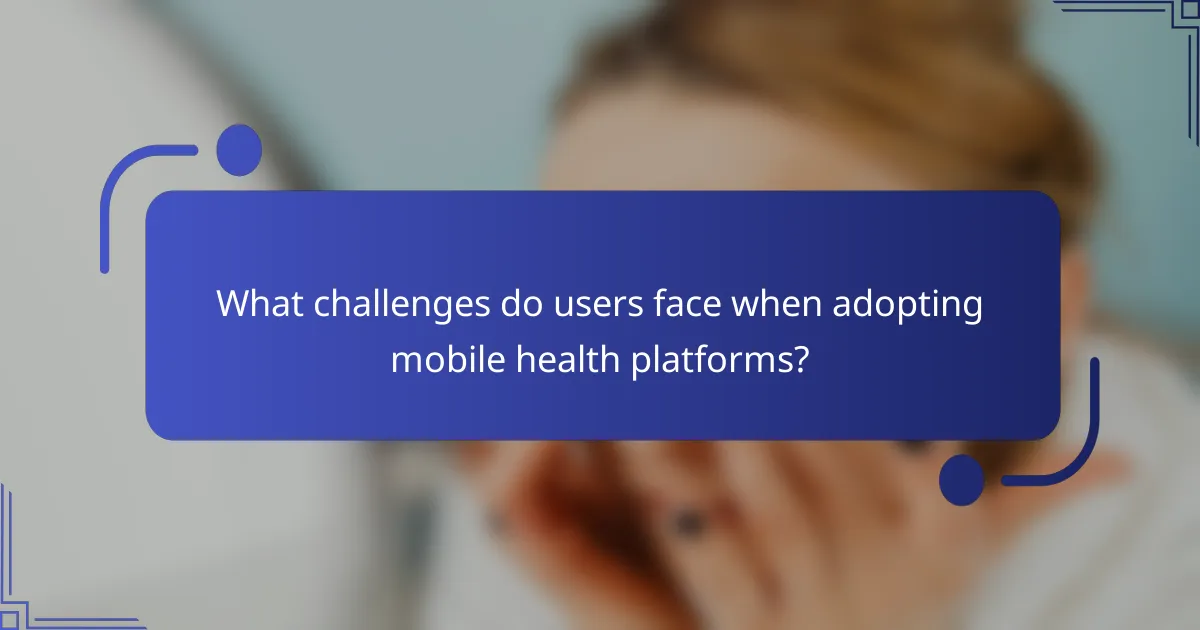
What challenges do users face when adopting mobile health platforms?
Users face several challenges when adopting mobile health platforms, including usability, data privacy concerns, and integration with existing health systems. Many users struggle with complex interfaces that hinder navigation. Privacy issues arise from sharing sensitive health information, leading to hesitance in adoption. Additionally, integration with existing health systems can be cumbersome, causing disruptions in user experience. These challenges can limit the effectiveness of mobile health platforms in enhancing nutrition management and wellness monitoring.
How do privacy concerns affect user trust?
Privacy concerns significantly impact user trust in mobile health platforms. Users are increasingly wary of how their personal health data is collected, stored, and shared. A lack of transparency in data practices can lead to skepticism and reduced engagement. Ensuring robust data protection measures and clear privacy policies can enhance user confidence. As a result, platforms prioritizing user privacy are more likely to foster trust and encourage consistent usage.
What technical barriers can hinder platform usability?
Technical barriers that can hinder platform usability include poor user interface design, lack of interoperability, slow performance, and inadequate support for diverse devices. These issues can frustrate users and limit engagement with mobile health platforms. For instance, a cluttered interface can make navigation difficult, while slow loading times can discourage regular use. Additionally, if a platform does not integrate well with other health applications, users may struggle to manage their nutrition and wellness effectively.
How does the digital divide impact access to mobile health solutions?
The digital divide significantly limits access to mobile health solutions, particularly in underserved populations. This gap affects the availability of technology and internet connectivity necessary for effective health management. For instance, individuals without reliable internet access cannot utilize mobile health platforms for nutrition management or wellness monitoring. As a result, disparities in health outcomes widen, emphasizing the need for targeted interventions to bridge this divide. Addressing these access issues is crucial for enhancing the overall effectiveness of mobile health solutions.
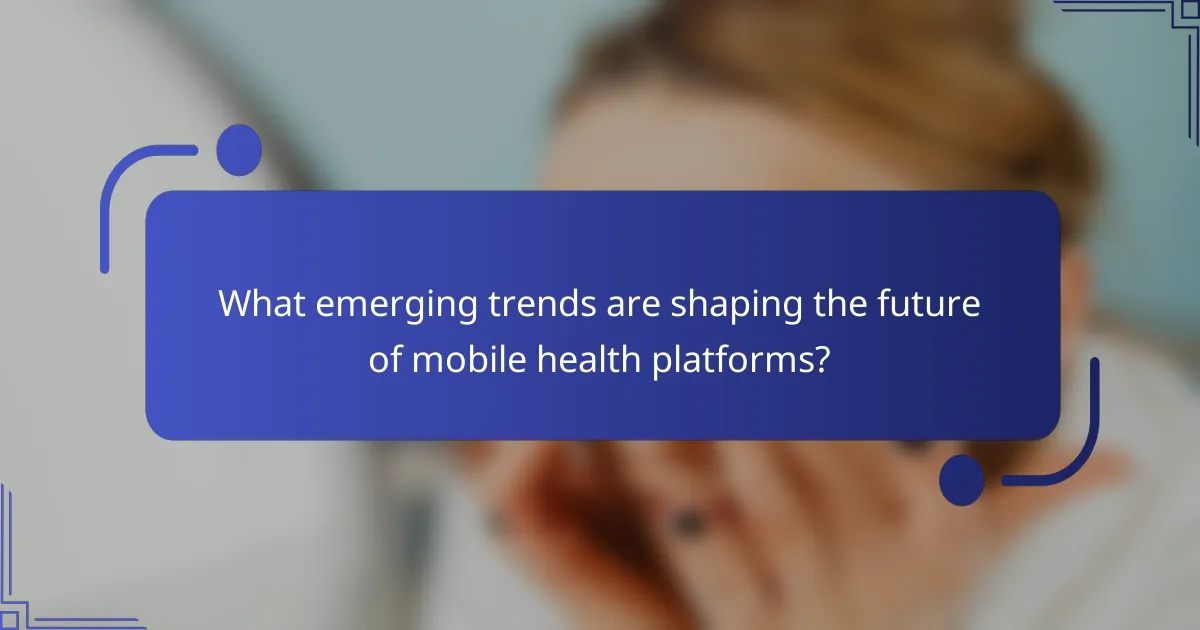
What emerging trends are shaping the future of mobile health platforms?
Emerging trends in mobile health platforms are revolutionizing nutrition management and wellness monitoring. Key developments include personalized health data analytics, integration of artificial intelligence for predictive insights, and enhanced user engagement through gamification.
The rise of telehealth services is also notable, enabling remote consultations and continuous health tracking. Furthermore, interoperability among various health apps is improving data sharing and user experience. These trends collectively enhance the effectiveness and accessibility of mobile health platforms, promoting better health outcomes.
How are artificial intelligence and machine learning transforming user experience?
Artificial intelligence and machine learning significantly enhance user experience in mobile health platforms by personalizing nutrition management and wellness monitoring. These technologies analyze user data to provide tailored recommendations, improving engagement and adherence to health goals.
AI algorithms identify patterns in dietary habits and activity levels, enabling platforms to suggest personalized meal plans and exercise regimens. This customization fosters a deeper connection between users and their health journeys.
Machine learning continuously refines these recommendations based on user feedback and outcomes, ensuring that the guidance remains relevant and effective over time. As a result, users experience a more intuitive interface that adapts to their evolving needs.
Additionally, predictive analytics can foresee potential health issues, prompting users to take preventive measures. This proactive approach transforms the user experience by empowering individuals to manage their health more effectively.
Which innovations are enhancing data security and user privacy?
Mobile health platforms are enhancing data security and user privacy through innovative technologies. These include end-to-end encryption, secure cloud storage, and biometric authentication.
End-to-end encryption ensures that data is encrypted from the point of origin to the destination, preventing unauthorized access. Secure cloud storage provides a centralized, protected environment for sensitive health data, minimizing risks of data breaches. Biometric authentication, such as fingerprint or facial recognition, adds an extra layer of security by verifying user identity.
Additionally, many platforms are adopting advanced data anonymization techniques. This process protects user identities while still allowing for valuable data analysis. As a result, these innovations foster trust and encourage more users to engage with mobile health platforms.
What is the role of telehealth integration in mobile health platforms?
Telehealth integration in mobile health platforms enhances patient engagement and access to care. It allows users to consult healthcare professionals remotely, improving convenience and adherence to wellness monitoring programs. This integration facilitates real-time health data sharing, enabling personalized nutrition management. Increased connectivity leads to better health outcomes and proactive interventions.
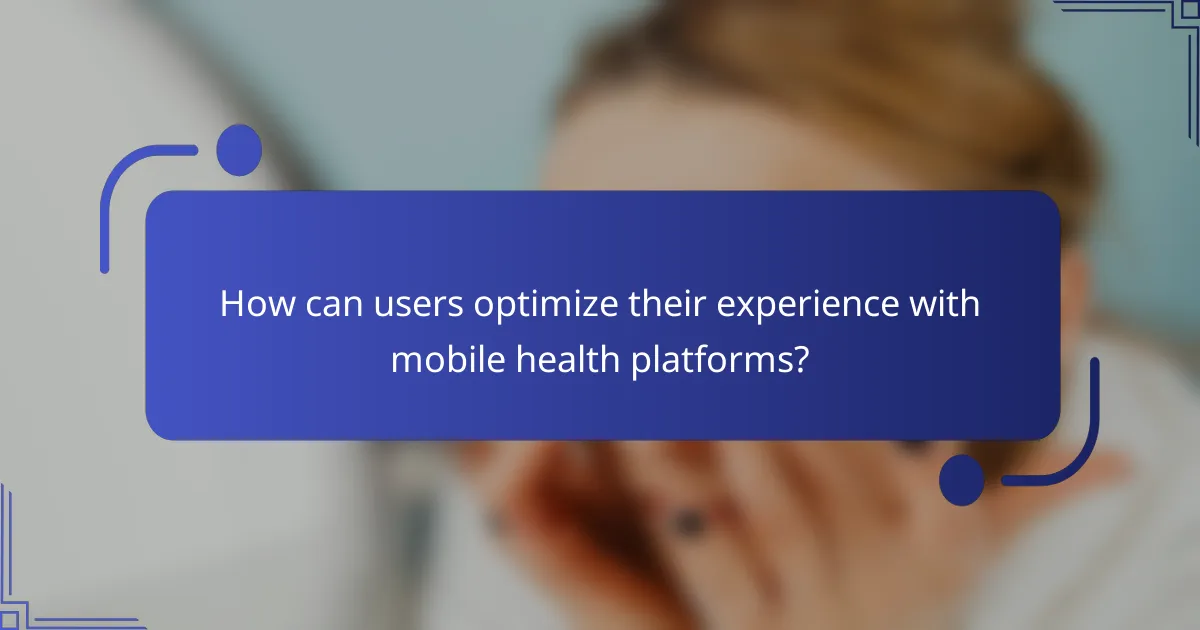
How can users optimize their experience with mobile health platforms?
Users can optimize their experience with mobile health platforms by leveraging personalized features and data tracking. Regularly updating health goals and preferences enhances the relevance of recommendations. Utilizing integrated nutrition management tools promotes balanced diets. Engaging with community support features fosters motivation and accountability. Regularly reviewing analytics from wellness monitoring can identify trends and areas for improvement.
What best practices should users follow for effective nutrition management?
To manage nutrition effectively, users should leverage mobile health platforms for personalized tracking and insights. These platforms enhance awareness of dietary habits, enabling users to monitor intake accurately and adjust as needed.
1. Set specific nutrition goals based on individual health needs.
2. Use food tracking features to log meals and snacks consistently.
3. Analyze nutrient breakdowns to identify areas for improvement.
4. Integrate physical activity tracking for a holistic view of wellness.
5. Engage with community features for support and motivation.
6. Regularly review progress and adjust goals as necessary.
Which common mistakes should users avoid when using wellness monitoring tools?
Users should avoid common mistakes like neglecting data accuracy, failing to set clear health goals, and overlooking app features. These errors can hinder effective nutrition management and wellness monitoring.
1. Ignoring data accuracy: Ensure input data is correct to receive reliable insights.
2. Lack of clear goals: Define specific health objectives for better tracking and motivation.
3. Overlooking app features: Explore all functionalities to maximize the tool’s potential.
4. Inconsistent usage: Regularly engage with the platform for the best outcomes.
5. Neglecting integration: Utilize compatible devices for comprehensive health tracking.
How can users leverage community features for better health outcomes?
Users can leverage community features on mobile health platforms to improve health outcomes through shared experiences and support. These platforms facilitate discussions, enabling users to exchange nutrition tips and wellness strategies. Engaging with a community can enhance motivation and accountability, leading to better adherence to health goals. Additionally, access to diverse perspectives can provide users with innovative approaches to managing their nutrition and wellness, ultimately fostering a supportive environment that promotes healthier lifestyles.


